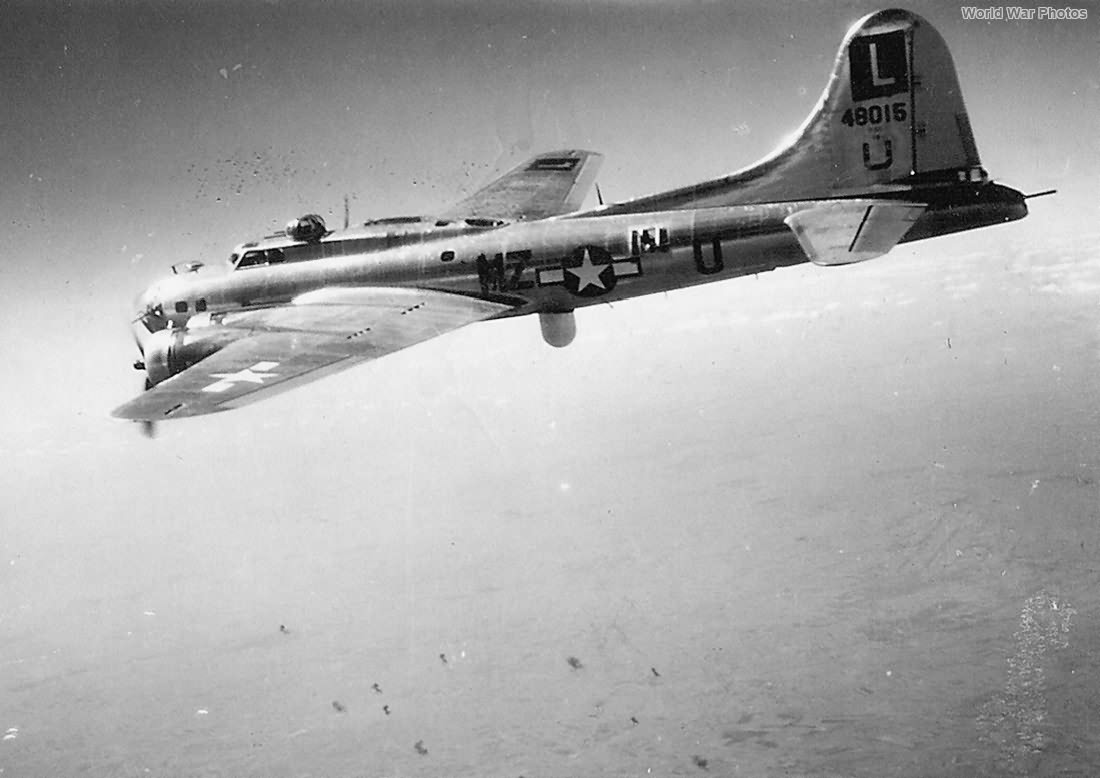The 452nd Bomb Group (Heavy):
Overview and Command Assignments
- Assigned to Eighth Air Force: January 1944 – August 1945
- Wing & Command Assignments:
- 3rd Bombardment Division (BD), 45th Combat Bomb Wing (CBW): January 1944
- 3rd Air Division (AD), 45th CBW: 1 January 1945
Component Squadrons
- 728th Bombardment Squadron (H): Squadron code M3
- 729th Bombardment Squadron (H): Squadron code 9Z
- 730th Bombardment Squadron (H): Squadron code 7D
- 731st Bombardment Squadron (H): Squadron code 6K
Combat Aircraft
- B-17G Flying Fortress: (from block 10 onwards)
Station
- Deopham Green, England: 3 January 1944 – 5 August 1945
- (Ground echelon arrived on 9 January 1944)
Group Commanding Officers (COs)
- Lt Col Herbert O. Wangeman: 1 June 1943 – 7 February 1944
- Lt Col Robert B. Satterwhite: 8 February 1944 – 27 February 1944
- Lt Col Marvin F. Stalder: 28 February 1944 – 29 March 1944
- Col Thetus C. Odom: 30 March 1944 – c. 24 July 1944
- Col Archibald Y. Smith: c. 24 July 1944 – c. 1 August 1944
- Col William D. Eckert: c. 1 August 1944 – 12 September 1944
- Lt Col Charles W. Sheburne: 13 September 1944 – c. 24 September 1944
- Col Burnham L. Batsor: c. 25 September 1944 – 6 June 1945
- Col Jack E. Shuck: 6 June 1945 – July 1945
Mission Details
- First Mission: 5 February 1944
- Last Mission: 21 April 1945
- Total Missions: 250 (including 5 food missions in May 1945, delivering 369.1 tons of supplies)
- Total Credit Sorties: 7,279
- Total Bomb Tonnage: 16,466.6 tons (including 150 tons of supplies)
- Aircraft Missing in Action (MIA): 110
- Other Operational Losses: 48
- Enemy Aircraft Claims: 96 destroyed, 45 probably destroyed, 58 damaged
Major Awards
- Distinguished Unit Citation: 7 April 1945 for the mission to Kaltenkirchen
- Two Medals of Honor:
- 1st Lt Donald J. Gott: 9 November 1944
- 2nd Lt William E. Metzger: 9 November 1944
Claims to Fame
- Notable Fact: The group had more commanding officers than any other bomb group during the course of hostilities.
Early History
- Activated: 1 June 1943 at Geiger Field, Washington
- Training Locations:
- Moved to Rapid City Army Air Base (AAB), South Dakota, on 15 June 1943 for training until early October 1943.
- Moved to Pendleton Field, Oregon, on 11 October 1943, then to Walla Walla Army Air Field, Washington, on 4 November 1943.
- Deployment:
- Ground echelon left for Camp Shanks, New York, on 23 December 1943 and sailed on the Queen Elizabeth on 2 January 1944, arriving in Clyde, Scotland, on 8 January 1944.
- The air echelon began its overseas movement in early December 1943 via the southern ferry route, with most aircraft reaching the UK a few days before the ground echelon arrived.
Subsequent History
- Redeployed to the USA: June-August 1945
- Aircraft left Deopham Green in late June 1945.
- Ground echelon sailed on the Queen Elizabeth from Greenock, Scotland, on 5 August 1945, arriving in New York on 11 August 1945.
- Personnel were given 30 days of Rest and Recuperation (R&R).
- The group was reestablished at Sioux Falls Army Air Field, South Dakota, and inactivated there on 28 August 1945.
Aircraft Markings and Color Schemes
B-17G Flying Fortresses (January 1944 – August 1945)
Original Paint Scheme: Dark Olive Drab and Neutral Gray factory finish.
- Group Marking: Square L
- Applied to the tail fin and the upper surface of the right wing in January 1944.
- On the tail fin: A white rectangle, mostly 60 inches high by 48 inches wide, with a black letter “L” (48 inches high).
- Variations: On many of the original aircraft, the ‘square’ was 48 inches high and 60 inches wide, overlapping the rudder. On others, the device was terminated against the rudder leading edge, reducing the horizontal measurement to 56 inches. The 728th Bomb Squadron used a distinctive 54-inch high by 42-inch wide ‘square’ from the spring of 1944.
- On the wing: The Square L dimensions were mostly 72 inches with the span and 57 inches with the chord, with the letter “L” sized and colored as on the fin.
- Natural Metal Replacements: Arriving in March 1944, the Square L was then white on black.
- Group Marking: Square L
Aircraft Call-Letters:
- On camouflaged B-17Gs, the individual aircraft call-letter was 20 inches high in yellow below the tail number.
- Squadron Markings: Introduced in the summer of 1944 using the bar and plus system (common in B-24 groups):
- 728th Bomb Squadron: A bar before the letter
- 729th Bomb Squadron: A bar after the letter
- 730th Bomb Squadron: No sign
- 731st Bomb Squadron: A plus symbol after the letter
- These symbols were painted in yellow on camouflage and black on bare metal, made with approximately 4-inch strokes, with an overall measurement of 12 inches.
High-Visibility Markings (January 1945):
- Two parallel yellow stripes on the outer wing sections, with the inner stripe bordering the section join, were 36 inches wide with a 60-inch separation. These markings were on the upper surface of the right wing and under the surface of the left wing.
- On the vertical tail surfaces, the lower yellow stripe was 36 inches wide on some aircraft and 48 inches on others; the higher stripe was 36 inches wide and positioned 60 inches above the lower. The existing markings were reinstated where obscured, with the call-letter being black on the yellow band.
Final Markings (May 1945):
- Squadron code letters were painted in black under the left wing with the call-letter.
- 728th Bomb Squadron: M3
- 729th Bomb Squadron: 9Z
- 730th Bomb Squadron: 7D
- 731st Bomb Squadron: 6K
- Squadron code letters were painted in black under the left wing with the call-letter.
